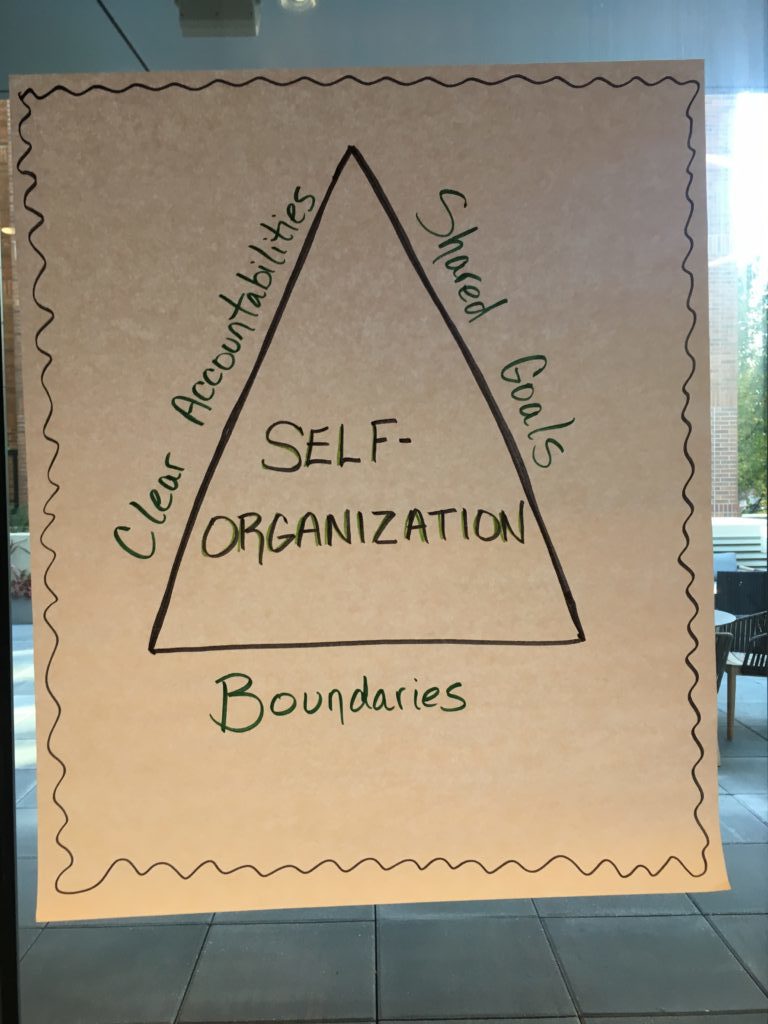
This is part of a series of posts about servant leadership to influence change and inspire greatness My goal is to make servant leadership more understandable and actionable for everyone regardless of your position, title, or status. Because this is the only way to create meaningful change in our complex world. Instead of feeding into division, fear, and disempowerment, we will lead by inspiring, enabling, and empowering.
Once you have started to create a strong foundation, the second action of an effective servant-leader is to empower and enable others.
It can be scary to give up control, to trust others to figure things out and to follow through on achieving results. Yet it is absolutely essential for the growth and success of others. Tapping into the collective intelligence is also what leads to the most creative and effective solutions to complex problems. In this post, we will explore how to create an environment for effective self-management (i.e. self-organization) and tap into what motivates people. Then you will be ready to navigate the choices of a servant-leader to empower and enable.
Effective self-management requires three things:

In a previous post, we detailed how to create a strong foundation. This work helps teams and organizations establish shared goals because there is a clear vision, value is understood, and there are mechanisms in place to validate actual results against desired outcomes. The success of teams, as well as multiple teams working together, must be determined based on the achievement of shared goals.
As a servant-leader, be watchful for structures and policies in your organization that undermine shared goals. For example, structures or policies that reward individual accomplishments without any meaningful focus on rewarding team success or organizational success can easily undermine self-management. Keep in mind that team success could mean a number of things, including increasing customer satisfaction, growing revenue, improving quality, shortening the time it takes to deliver value, growing the knowledge and skills of the team (and more).
Consider how individuals are rewarded for teamwork and team outcomes in your organization.
Clear accountabilities help people focus on what is most important. And they often create a healthy tension that forces creative and productive collaboration when there are many factors to consider in decision-making. As an example, in Scrum there are three roles: the Product Owner is accountable for value (i.e. the “why” and “what”), the Developers are accountable for instilling quality as they create Increments (i.e. the “what” and “how”), and the Scrum Master is accountable for the health of the empirical process and the team (i.e. servant leadership or the “care and feeding” of others).
By having one team with three distinct accountabilities, there is clarity to what each person is focused on, as well as the healthy tension for collaborative problem-solving. A Product Owner may want more value, however, Developers do not cut quality in order to deliver more. The Developers may want to build the coolest feature using the latest technology, however, a Product Owner helps guide value-based decision. Instead of getting sucked into the details of doing the work, the Scrum Master can observe behaviors and outcomes, create greater transparency, remove impediments, and support the rest of the Scrum Team in more effectively fulfilling their roles to deliver valuable solutions.
Consider how these accountabilities show up in your team. Consider how closely the accountabilities are in alignment with how people are spending their time and measuring success.
Boundaries provide guidance for individuals and reduce the risk of failure.
Think of bumper cars. At first glance, it seems a bit reckless and crazy to get into one, but you soon realize that the cushioned barrier forming the edge of the rink and the protective barriers around each car provide safety. You cannot get up too much speed to hurt yourself or someone else. You cannot stray outside the protected area.
Boundaries show up in Scrum with timeboxes. The Sprint itself is a boundary that helps reduce risk because the worst case scenario is you fail to deliver the desired value in a Sprint. Instead of going down a path for months before figuring out it is not the right path or no longer worth the investment, a team is bounded by time to deliver something small of value, inspect how it went and the outcome, and then adapt based on what was learned and what has changed. The shorter the Sprint, the more you reduce risk and cost of failure. A Scrum Team can self-manage by determining their goal and how best to meet it within the boundary of time, no more than one month.
Boundaries also show up when you clarify what decisions are delegated to individuals and teams. For example, perhaps a team has clear boundaries for when they must consult the legal department or the security team for specific types of product decisions. Another example is a manager who delegates managing a vacation calendar to a team, allowing them to ensure a sufficient amount of coverage and stay within allocated vacation days.
The key is to find the right boundaries, and this is more of an art than a science. If a team is too constrained, they may be missing out on creativity, learning, and growth. If a team is not constrained enough, there may be too much divergence, chaos, or lack of collaboration.
Consider how timeboxes that enable quick delivery of small pieces of value and feedback loops can be helpful. Consider how clear and how constrained the team’s decision-making boundaries are and the potential positive or negative impacts of that.
Leaders don’t motivate people. Leaders create the conditions that tap into intrinsic motivation.
This is the big why for empowering and enabling others. When people are intrinsically motivated, they are more likely to bring their best and most creative selves to their work. That’s how people solve complex problems, adapt to new challenges, and drive themselves and each other towards continuous improvement.
In Dan Pink’s widely-acclaimed book Drive, he presents research that knowledge workers must be motivated intrinsically rather than through systems that use extrinsic rewards/ punishment (i.e. carrot/ stick). Intrinsic motivation requires three things: autonomy, mastery, purpose.
I often get asked questions like:
I always come back to the Co-Active Coaching principle that people are naturally creative, resourceful, and whole. We simply need to create the environment for them to bring their full selves to their work. And then I challenge the perspective.
How would you feel if I told you I didn’t think you were capable of talking to your co-workers to create work plans and solve problems?
How would you feel if I decided that you were no longer capable of managing your goals, progress, and plans because you made a mistake.
Yeah, it feels kind of crappy. You might feel disrespected. You might feel afraid of making a mistake. It might be demotivating, and you might decide this isn’t worth your full focus, energy, and creativity. Eventually, good people leave situations that feel this way.
It may seem scary to give up control, to trust others, to truly measure your own success by the growth and success of others.
But there isn’t a viable alternative that will guarantee success in a complex world.
Instead of directing, controlling, and predicting, put your effort into what has potential for the greatest payoff.
And yes, if the team fails, that is your failure as well. If you cannot live with that, then you are not a servant-leader. People have to know you stand by them, you support them, you will protect them, and you believe in them. Failure is inevitable with complex work, and learning comes from failure.
Consider how your own actions or inaction may or may not have served their growth and success.
Create an environment where people are intrinsically motivated and can effectively self-manage based on a strong foundation. And then navigate your day-to-day choices letting your role as servant-leader guide you. In part 2, we will explore how to navigate your choices as a servant-leader.



AGILE SOCKS is a registered trademark of Agile Socks LLC. Other marks used herein are the property of their respective owners. For more information see Trademark Notice in Terms & Conditions.